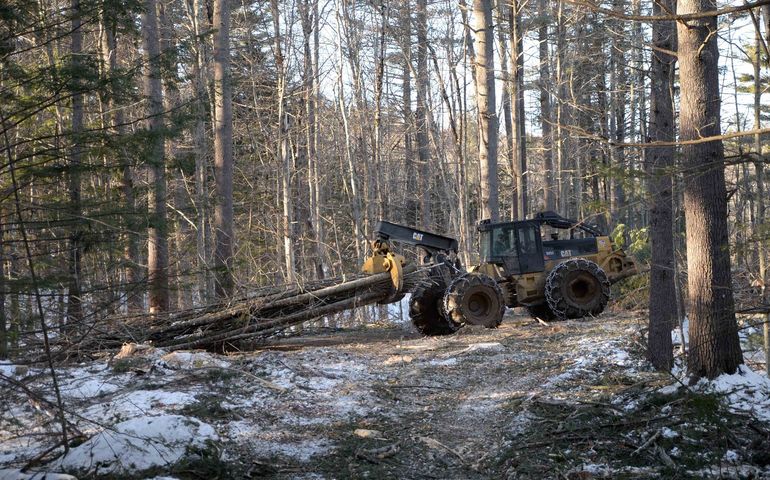Logging and the trucking of wood supports 9,366 Maine jobs either directly or indirectly, as well as a range of industries and communities across Maine, according to a new analysis of the most recent figures available.
The Augusta-based Professional Logging Contractors of Maine this week released the study, “The Economic Contribution of Logging and Trucking in Maine,” which was conducted by the University of Maine and the Margaret Chase Smith Policy Center.
The study says the logging and woods trucking industry also contributed an estimated $619 million to the state economy in 2017, the latest figures available.
“This study demonstrates the vast impact logging has on the Maine economy and highlights its role as the foundation of the state’s entire $7.7 billion forest products industry,” Dana Doran, executive director of the Professional Logging Contractors of Maine, said in a news release. “It also shows what Maine stands to lose if the mounting challenges to the logging industry are not overcome.”
To better understand the nature of the harvesting industry in Maine, analysts combined a traditional input-output analysis with primary data gathered from member companies of the Professional Logging Contractors, the trade association representing companies that together account for more than 75% of all timber harvested in Maine. Census data and information from the U.S. Bureau of Labor Statistics was also incorporated.
In addition to overall economic impact and jobs, the study and associated research presented a range of findings.
Mechanization reigns
- The real average wage for workers in the logging industry in 2017 was $47,289 (in 2018 dollars). This represents a 3.2% increase in wages since 2014.
- Of surveyed firms, 56% were whole tree harvesting operations, and another 35% as cut-to-length harvesting operations – both of which use combinations of mechanized logging equipment such as feller bunchers, delimbers, grapple skidders, forwarders, and harvesters to cut, yard, and process wood.
- Only 8% of the firms were identified as conventional hand crews using chain saws. Respondent companies employed slightly fewer crews on average in 2018 than in 2014. The proportion of cut-to-length crews in mechanized logging, although still a minority, increased in 2018.
- Maine’s logging sector is heavily dominated by small businesses, with an average (between 2006 and 2016) of 67% of employing establishments in the industry employing fewer than five people. Additionally, 1,719 non-employer entities in the logging and harvest sector were reported in Maine during 2017. These entities are overwhelmingly (94%) run by sole proprietors.
- Survey respondents reported an average of 13 full-time equivalent employees per firm. As in 2014, the majority of respondent employees work in the woods, on average seven per firm; an additional average of two per firm provide office support, three trucking and one mechanical support. The average number of wood-based employees per firm, as calculated from survey responses, is a little more than half of what it was in 2014.
- On average, survey respondents had 42 operational weeks in 2018 and harvested 1,621 acres per firm.
Trucking essential to logging
- Most survey respondents trucked either all or most of the material harvested by their firm. Thirteen percent rarely (less than 50% of the time) trucked their own material and 24% contracted with an outside source for all their trucking needs.
- Logging is a capital-intensive industry. Survey respondents reported $21.1 million in new capital investment, and 76% of that was spent on new equipment.
- For 2018, 11.8 million tons of timber were harvested in Maine, including 4.2 million tons of saw timber, 5.4 million tons of pulp wood, and 2.2 million tons of biomass. That was an overall decrease of from 2014, when data showed 14.1 million tons of timber were harvested in Maine, including 4 million tons of saw timber, 7.3 million tons of pulp wood, and 2.9 million tons of biomass.
- The economic study comes in the wake of a 2019 Maine Logger and Log Trucker Employment Availability and Wage Analysis Report prepared by the Maine Center for Business and Economic Research at the University of Southern Maine.
- That report found Maine is facing a shortage of loggers and log truckers that will grow and which could hinder the growth of the forest products industry in the state if wage growth does not occur. The report also indicated that wages for logging equipment operators and log truckers in Maine are lower than those for comparable jobs in competing industries in the state.
Dwindling profits
“The inevitable conclusion based on a review of the new study and of the wage and employment study released last year is that logging is a critical Maine industry under threat that must be preserved if the state is to avoid a collapse of its forest products industry and the deep and irreversible impacts that would have on Maine’s economy, rural communities, and character,” Doran said. “The challenges facing loggers are not insurmountable, but failure to overcome them would be disastrous for Maine.”
Doran said that one key to the future of the increasingly complex logging industry is education, such as the Mechanized Logging Operations Programs the PLC has created in partnership with the Maine Community College System. The program is currently recruiting students for its fourth 12-week class, scheduled to begin June 22 in the Old Town area. For more information, click here.
